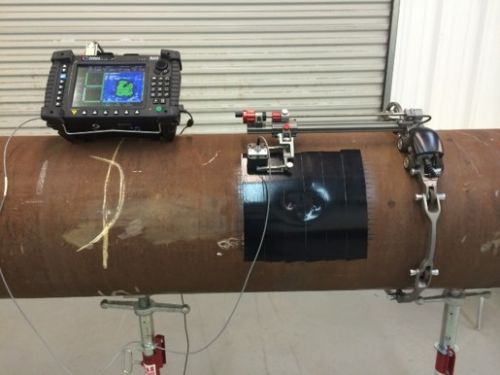Introduction
Detecting and characterizing hard spots (localized hardening) in carbon steel pipes is critical to maintaining the integrity of pipelines. Olympus developed a solution that combines a high-sensitivity eddy current probe with the OmniScan® MX and ECA module.
Challenge
There are two main ways that localized hardening occurs in a pipeline. It can be produced by unintentional quenching during the manufacturing process or by accidental cold work (denting) during operation. The former can change the metallurgical structure of the steel pipe thereby creating martensite, a very hard form of steel, while the latter causes locally induced residual stress. Both of these localized hardened areas in the pipe can be the initiation point of hydrogen stress cracking (HSC).
In ferromagnetic pipes, such as carbon steel, the magnetic permeability is affected by changes in the metallurgical structure and residual stress. This property is used to detect and characterize hard spots with eddy current.
Solution
Olympus’ solution is based on a specially designed eddy current probe that is highly sensitive to permeability changes in carbon steel components.
The solution requires the use of a two-dimensional scanner that provides 2-axis encoded positions to the OmniScan MX ECA (Figure 1). The operator has to balance the EC probe on the carbon steel pipe to center the operation point on the impedance plane. Using the scanner, the operator scans the surface of the pipe. When the probe runs over an area where the permeability changes the operating point changes position, and it is displayed in the C scan, the impedance plane, and the strip chart of the OmniScan MX ECA.
 |
| Figure 1. A system composed of an OmniScan MX ECA, 2-axis scanner, and EC probe. |
Results
The technique was tested on preheated carbon plates that were locally quenched at different temperatures. The resulting C-scan is shown below (Figure 2). The C-scan is a color-coded mapping where the vertical component of the voltage is represented by different colors. White and blue are very low voltages, which correspond to the normal permeability of the steel component, while pink and red are higher voltages, which represent areas where the permeability of the component has changed. The hard spot (the bright pink and red area) is clearly displayed on the C-scan, and its position and size can be measured. The intensity of the hard spot’s voltage indicates the severity of the change in permeability as well as the degree of hardening.
 |
| Figure 2. C-scan image of a hard spot caused by water quenching. |
The technique was also tested on pipes with dents. Again, the dented area was scanned with the eddy current probe, and the resulting C-scan is shown below (Figure 3). The zone where the permeability changes is represented by the green color (higher voltage), and the permeability of the undamaged pipe is represented in white and blue (low voltage). Special attention is required to keep the probe in contact with the damaged surface of the pipe.
 |
| Figure 3. C-scan image of a hard spot caused by accidental cold work (denting). |
Conclusion
Olympus developed an effective solution that uses a specially designed, highly sensitive eddy current probe combined with the OmniScan MX ECA system to detect and characterize hard spots on carbon steel pipe.

